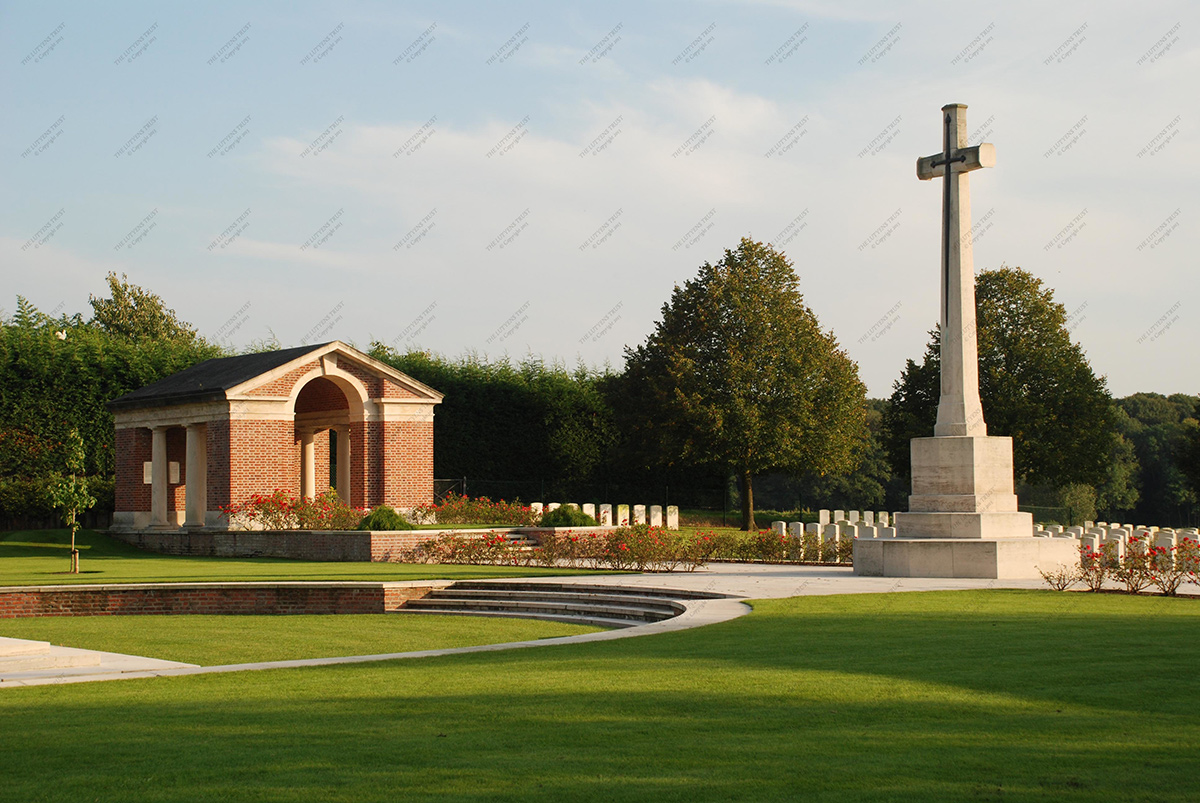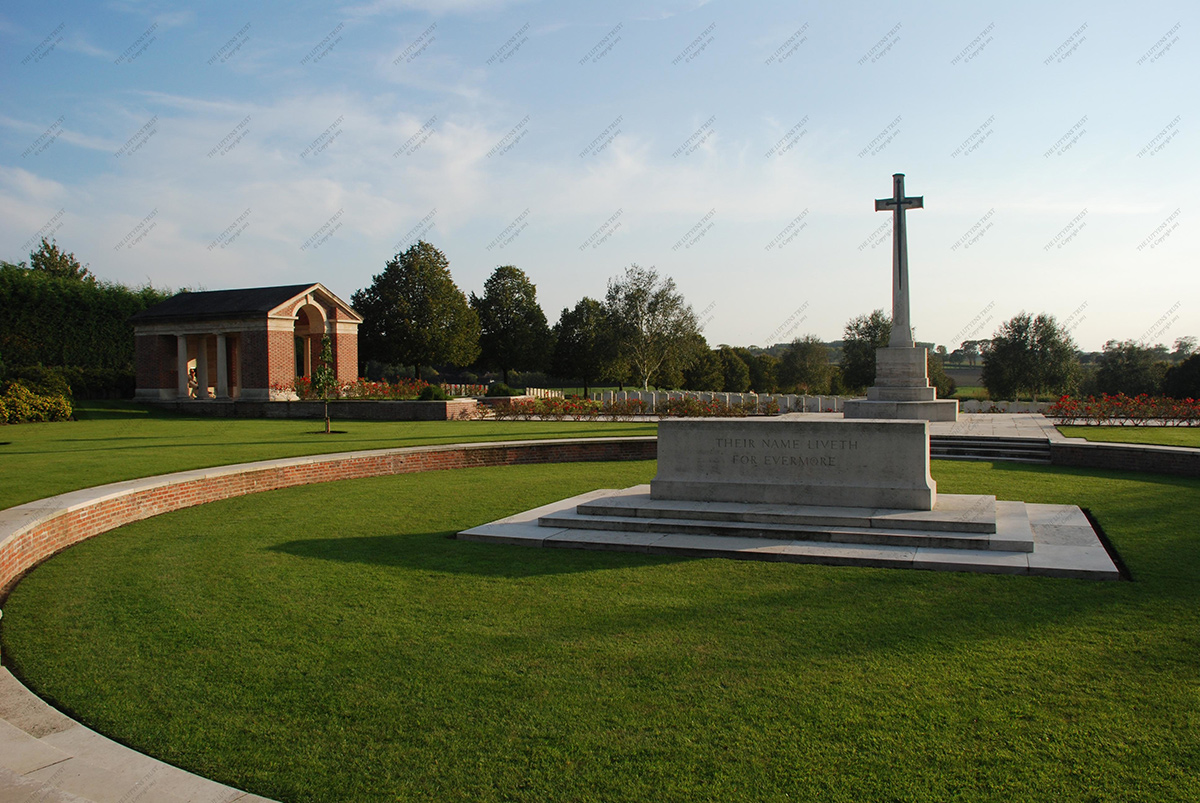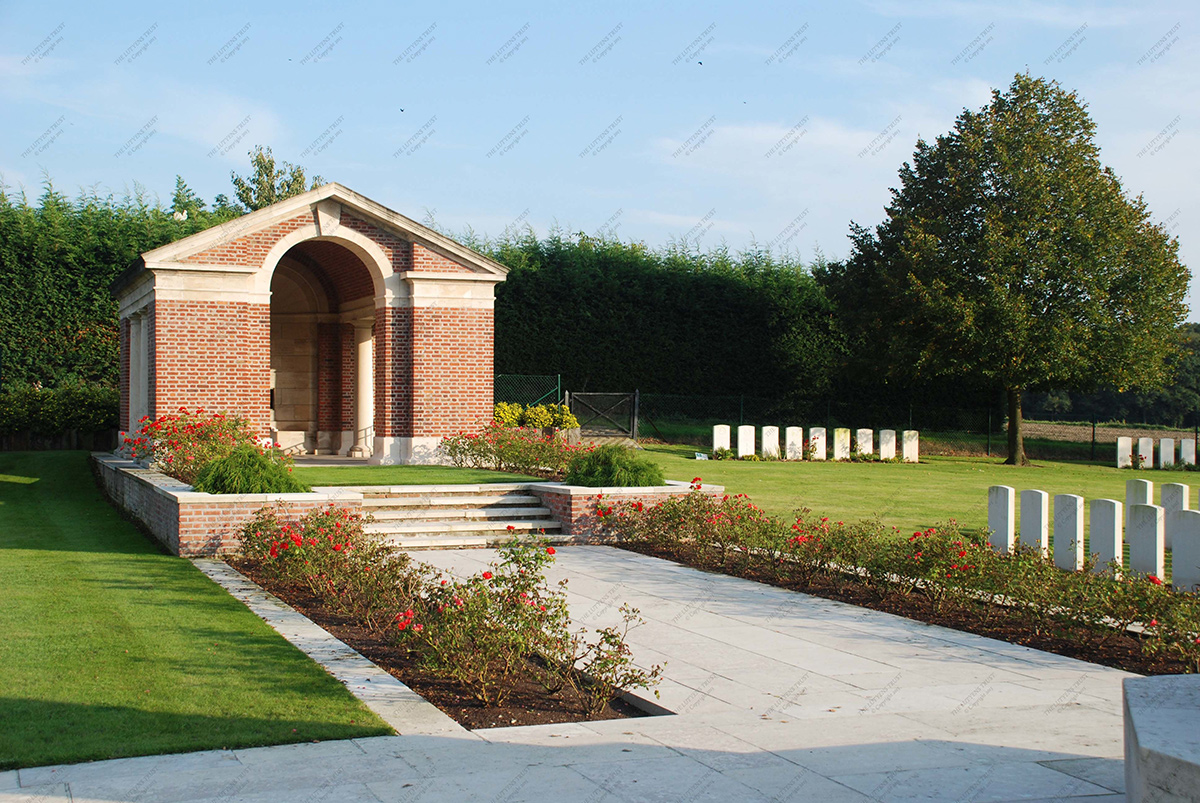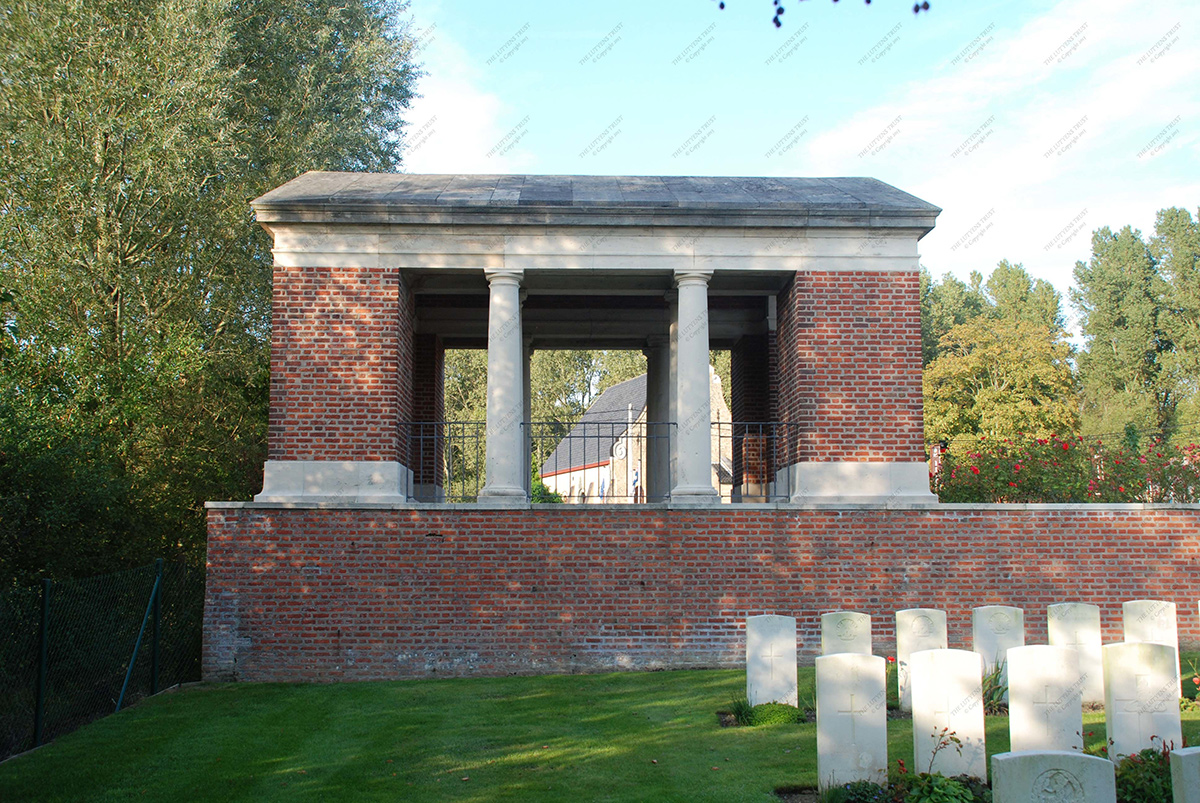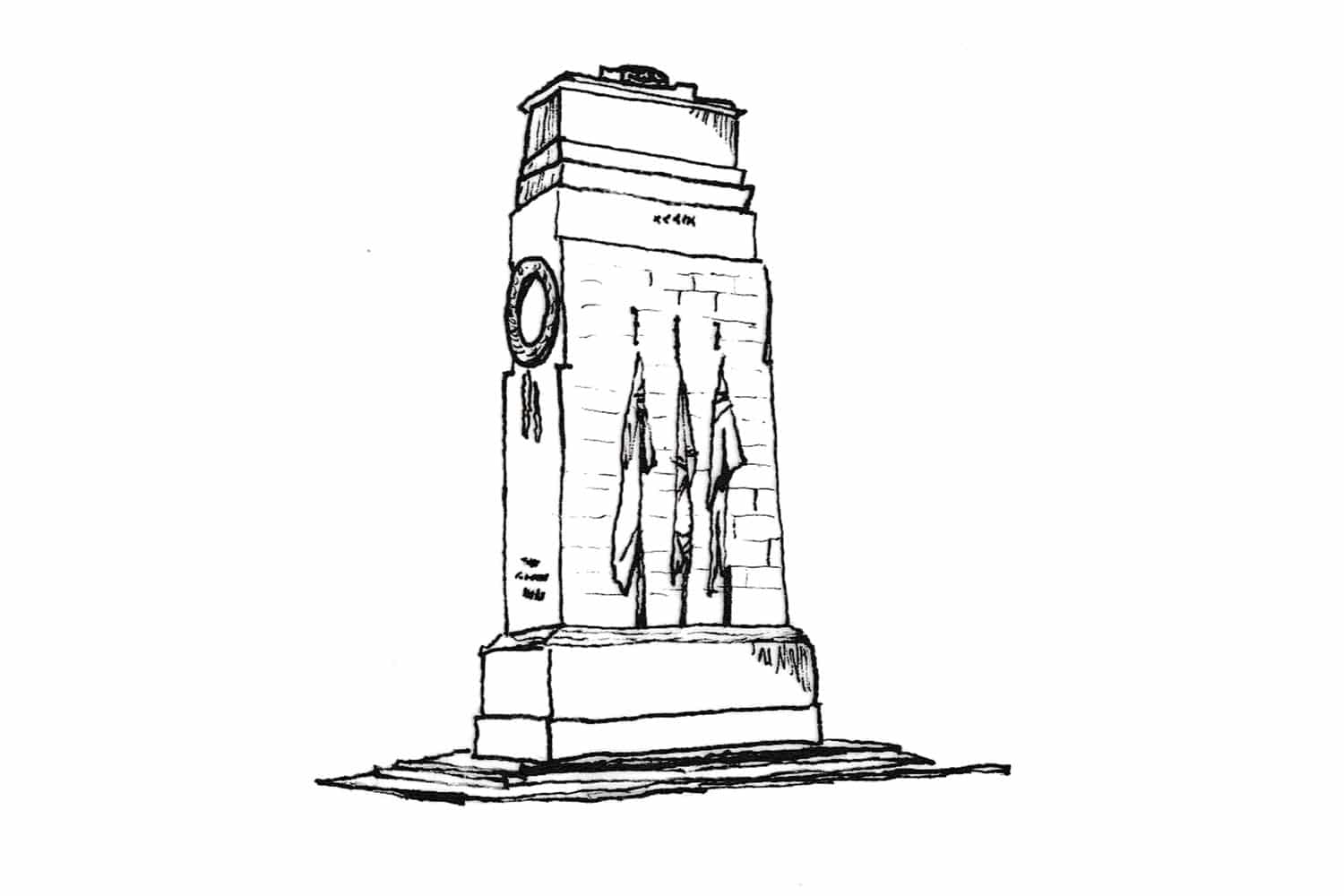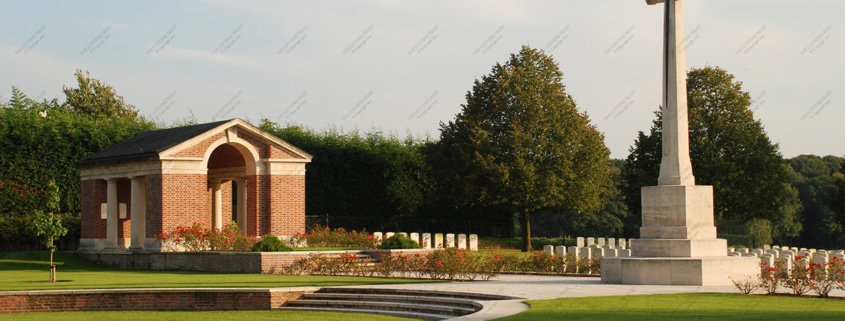
Description
Hooge Chateau was the scene of heavy fighting throughout the war. The castle accommodating the staff of the 1st and 2nd divisions was hit by a bomb on 31 October 1914. The castle was once again defended against German attacks between 23 May and 3 June 1915, and in July an exploding mine, placed there by the Third Division, created a crater on the north side of the road with a depth of fifteen metres and a diameter of over fifty metres.The Germans conquered it once again on 6 June 1916 and more than a year later, on 31 July 1917, the 8th division advanced a mile beyond the castle. The Germans, however, recaptured it a final time in April 1918, when the first part of the cemetery had already been constructed, and eventually it fell into the hands of the 9th Scottish division and the 29th division on September 28. Hooge Castle was rebuilt after the war, near its original location. The crater is now a picturesque pond. The former castle grounds are currently an amusement park. A private war museum has been established opposite the cemetery.
Initially the cemetery contained seventy-six graves, in the rows a to d of plot i, but witnessed a huge extension after the Armistice, when graves were added from the battlefields of Zillebeke, Zantvoorde and Gheluvelt and from smaller cemeteries in the vicinity. Various special memorials have been installed in the cemetery. The field lies on a gentle slope on the south side of the road from Ypres to Menen, in an open landscape. As the ground descends, the plateau offers a fine view of the cemetery and the surrounding landscape.
A horizontal plateau has been installed on the slope, on the side of the road, with a sunken circular part with the War Stone in the middle. The circle recalls the bomb crater of July 1915. In fact, bomb craters were often used to bury soldiers collectively. There are also three crater cemeteries north of the town of Arras. Around Ypres too there are cemeteries where headstones have been placed in a circle by way of memorial. One of these is the nearby Railway Dugouts Burial Ground, designed by Lutyens. However, in Hooge Crater Cemetery it does not concern a collective grave. The Cross of Sacrifice has been placed behind the War Stone, between two shelters. As the visitor enters the cemetery next to the War Stone and the Cross of Sacrifice, the climax is at the entrance and consequently the cemetery proper is a tranquil continuation. Beyond the Cross of Sacrifice, several steps lead to the cemetery, which is symmetrical in its layout. The ground has a gentle slope along the lateral axis as well, the difference in height is more evident near one shelter, which makes the entrance plateau more prominent.
The two shelters have been raised in the combination of red brick and white stone that is so typical of Lutyens. Various classical motifs have been combined in the architecture, such as the Greek temple and the Roman triumphal arch with the brick barrel vaulting. The pitched roof of stone with the housed gutter showing no distracting details is rather special. The buildings are different from those in the two cemeteries close-by, Sanctuary Wood Cemetery and Maple Copse Cemetery, which were designed in con- junction with the same assistant. They are very similar to the shelters of natural stone in Serre Road Cemetery No. 2 near the Somme, which were also done with Rew as the assistant. Halfway along the cemetery there are two inconspicuous toolhouses of brick.
The entrance has been placed between two slabs of stone with several steps and the name of the cemetery in between. A fence was placed at the bottom of the steps at a later stage. There are four stone posts on the side of the road. The cemetery is not at right angles to the road, but this has deliberately not been made a design theme in spite of the opportunity offered by the circle.
The plateau on the side of the road is a few steps lower; these have been incorporated in the entrance. The sunken circular part is accessible by way of steps. In fact, as a result, the War Stone is located at a considerably lower level than the entrance and the Cross of Sacrifice is directly visible. Around the War Stone, the difference in elevation is almost half a metre and the edge can therefore be used as a seat. From the plateau a broad stairway leads to the cemetery, where the first few headstones have been placed right in front of the steps. A second plateau with a small stairway has been installed at the far southern end. A hedge borders the cemetery.
The cemetery is of a symmetrical layout round a central axis, with an entrance in the middle. The War Stone is at the front, on the northeast side. The two shelters are at the ends of the cross axis and the Cross of Sacrifice has been placed at the intersection of the two axes. The graves, how- ever, face the low southwest side and the view, probably to realize a connection with the part of the cemetery that had already been constructed in 1917. An old photograph shows that the part in front at the left, where there is now an open space with the special memorials, once contained many wooden crosses, which may suggest the presence of German graves that were removed at a later stage. A number of collective graves have been marked with one single head- stone. The cemetery is bordered longitudinally by lime trees planted at every fourth row of stones. The five side paths are lined with pairs of birches, placed alternatingly at smaller and greater distances from one another, thus breaking the linear direction. There are rows of stones with backborders between the side paths, to reinforce that impression. On a slightly raised plateau at the end there are four red-leafed beeches. (Geurst, 2010, pp.328-331)
Bibliography
Geurst, J. (2010) Cemeteries of the Great War by Sir Edwin Lutyens. Rotterdam: 010 Publishers.Also Cited In
Listing Grade
Coming soonListing Reference
Client
Imperial War Graves Commission
